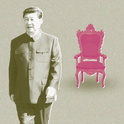Everywhere, prices of goods that loom large in the economy are falling—food, communications, energy (see Ed Davey, p18). Even a standard smartphone can fulfill almost all of the functions of a desktop computer (see “The internet of things,” below).
“Vloggers”—video bloggers discussing youth culture—make short videos in their bedrooms for YouTube, for instance. Millions watch the vlogs; the most successful can make hundreds of thousands of pounds in advertising revenue. Cheaper technology has also helped to drive economic progress in developing economies. M-Pesa, for example, the mobile payments system which allows users to send each other money via text message, now has over 12m users across Africa. The “developed” west, where technology is now being trialled, may soon catch up. Agricultural technology is cheaper, most importantly fertiliser, because of the lower price of oil. In the UK, fertiliser costs were down 6.2 per cent in the year to August and seed, fuel and feed costs were down 1.8 per cent. Since mid-2012, the cost of corn on global markets has halved. Lower food prices are welcome in both emerging and developed economies.
The falling price of oil—as a consequence of the Chinese slowdown, the US’s new proficiency in fracking for shale gas, and the Organisation of Petroleum Exporting Countries’ decision in November to keep its oil output at 30m barrels per day—has come as a boon to businesses and households worldwide. Down from a peak of $147 per barrel, in late November the oil price fell below $70.
Advances in wind and solar power are driving down the price of alternative energy. In the US between 2008 and 2012, the price of installing solar power declined by just under two-fifths, in a long-term trend which has seen costs plummet. In the US the cost of generating a watt of solar energy has fallen from $76 in 1977 to just 74 cents in 2013 (see chart). The coming year will see prices fall further.
But the downside is the threat of deflation. In the eurozone, inflation remains at 0.4 per cent a year, way below the European Central Bank’s target of 2 per cent. The worry is that the eurozone is sliding towards deflation, where prices fall in a self-reinforcing downward spiral, as in Japan during the 1990s. Deflation increases the burden of debts and discourages people from spending, as they assume prices will fall further and so decide to wait.
Lower prices are a good thing—so long as they do not fall too far. The health of the global economy in 2015 will depend on whether this balance is reached.

Advances in wind and solar power are driving down the price of alternative energy
Big ideas of 2015: Falling costs
Lower prices are a good thing—so long as they do not fall too far. The health of the global economy in 2015 will depend on whether this balance is reached
December 10, 2014












